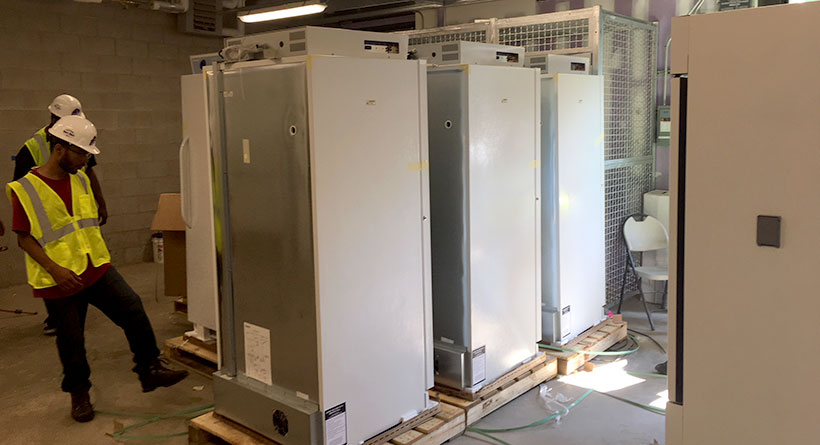
Jess Martin was on a mission, and it involved a lot of green stickers. Just weeks before the opening of the new Science Center, she stopped into a soon-to-move biology lab in Merrill, where a giant Westinghouse freezer bore the aging notices Chemical Attendant Use Only and Yeast Plates Here. Martin, the administrative director of the new science building, slapped a sticker on the front, marking the freezer’s pending demise.
“It’s unbelievable how old some of the things are,” she said, noticing the product name on the side of one refrigerator. “Hotpoint. The last year they made this fridge was 1977.”
Together with Laura Draucker, director of sustainability, Martin spent the summer quietly replacing aging, electricity-hogging science fridges and freezers. The project—the first to use the College’s Green Revolving Fund—involves 32 pieces of equipment and is expected to pay for itself in roughly 11 years.
This fund, established in 2016 by Prince Albert Grimaldi II ’81 of Monaco, finances projects that reduce energy use and greenhouse gas emissions. By reinvesting the savings, the program is designed to be self-sustaining.
The new equipment—four freezers that cool to minus 80 degrees Celsius, plus 14 scientific freezers and fridges, 12 conventional freezer-top fridges and two chest freezers—will save roughly 51,300 kilowatt-hours of electricity each year. Some of the old refrigerators are so inefficient that the new ones will “pay for themselves in a year,” says Draucker. “It’s the icing on the cake of energy savings.”
The old equipment lasted as long as it did in part because there was no real incentive to replace it, Draucker says: energy costs are absorbed by the College’s bottom line, and departments don’t see the bill, so there’s little motivation for faculty to push for upgrades—especially if existing equipment works well.
What’s more, says Professor of Biology Caroline Goutte, “every time you get a new freezer, you don’t know whether you can trust it. We always have a bit of hesitation when we put our entire career into a brand-new box and plug it in and have to walk away and assume it will work.”
Goutte’s research involves creating new strains of a nematode worm—strains that need to be kept frozen at minus 80 degrees Celsius. The material is so delicate that, during the few minutes of transport to the new building, special trucks were required to keep her strains cool.
“Many of us are genetic engineers,” she says. “We create strains that have genetic modifications, and then we freeze them and keep using and reusing them. If they disappear, it’s five years of work down the tube.”
Goutte and her colleagues affectionately named the new freezers Gregor, Charles, Nettie, Maud and Carl. “It is much easier to talk about moving samples ‘to Gregor’ than to say, ‘into the freezer in room B221f in the Goutte lab.’” They’re named for geneticist Gregor Mendel; naturalist and biologist Charles Darwin; Nettie Stevens, who discovered sex chromosomes; biochemist Maud Menten; and microbiologist Carl R. Woese ’50.
When they arrived at the Science Center loading docks, Draucker and Martin affixed a new sticker to each. This one was green and purple, with the logo for the College’s Office of Environmental Sustainability.